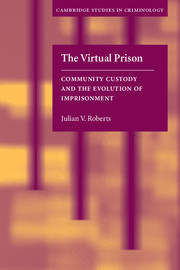Book contents
- Frontmatter
- Contents
- List of figures and tables
- Foreword by Andrew Ashworth
- Preface
- 1 Introduction to the concept of community custody
- 2 The way we punish now
- 3 Conceptualizing community custody
- 4 Representative models of community custody
- 5 Coming home to prison: offender perceptions and experiences
- 6 The effect of community custody on prison admissions
- 7 Public attitudes to community custody
- 8 Making community custody sentences work
- Notes
- References
- Index
Preface
Published online by Cambridge University Press: 07 December 2009
- Frontmatter
- Contents
- List of figures and tables
- Foreword by Andrew Ashworth
- Preface
- 1 Introduction to the concept of community custody
- 2 The way we punish now
- 3 Conceptualizing community custody
- 4 Representative models of community custody
- 5 Coming home to prison: offender perceptions and experiences
- 6 The effect of community custody on prison admissions
- 7 Public attitudes to community custody
- 8 Making community custody sentences work
- Notes
- References
- Index
Summary
In 1996, community custody came to Canada, when Parliament created a new community based form of custody called the conditional sentence of imprisonment. Since then I have been grappling with understanding this sanction in light of similar developments in other jurisdictions. It struck me that one way to understand the nature and potential of this sanction was to write a book about the topic. Whether I have achieved this understanding, the reader alone will decide.
Some readers may find the central thesis – that community custody with house arrest should be more widely used – inherently conservative; an attempt to promote punishment, and to recreate the conditions of imprisonment in the last refuge from state power: our homes. To these readers I would add (if they are still reading) that community custody should only ever be used as a substitute for secure detention, and that community custody permits offenders to influence their lives and the sentences they are serving. This can only but benefit these individuals, their families and the communities to which they belong.
I would like to thank the following for funding assistance with respect to the research reported here: the Social Sciences and Humanities Research Council of Canada; the Department of Justice, Canada and the University of Ottawa. As well, I am grateful to Tom Finlay and the library of the Centre of Criminology at the University of Toronto, and Noella Morvan and the library of the Ministry of the Solicitor General in Ottawa for bibliographic assistance.
- Type
- Chapter
- Information
- The Virtual PrisonCommunity Custody and the Evolution of Imprisonment, pp. xiii - xivPublisher: Cambridge University PressPrint publication year: 2004

